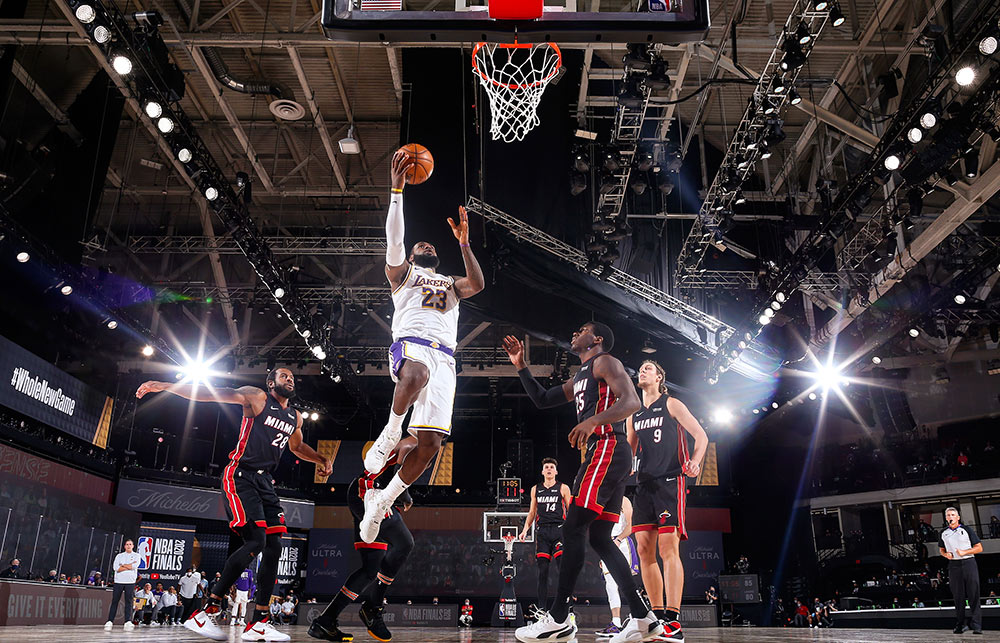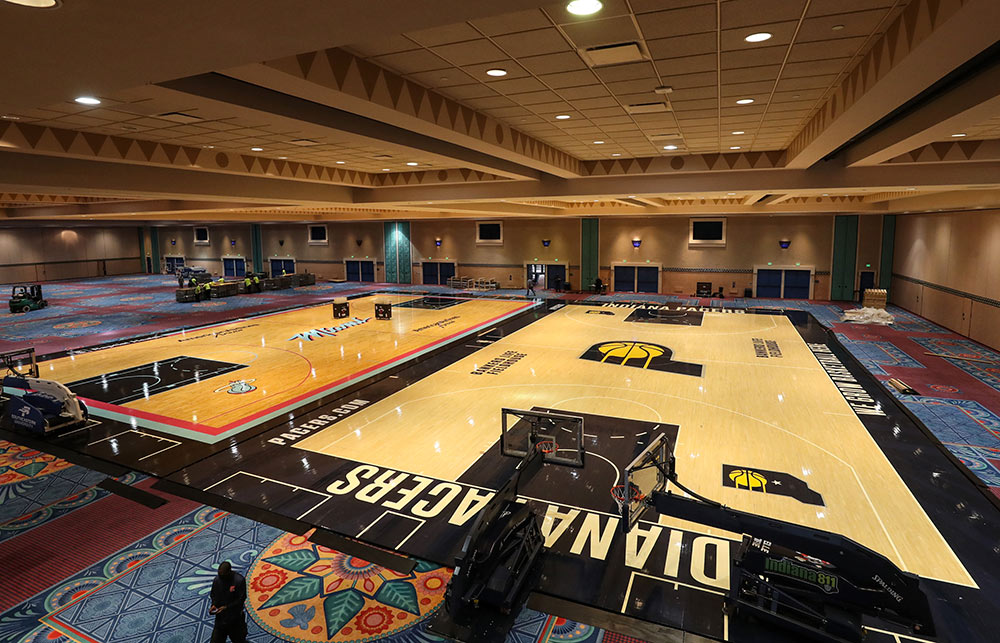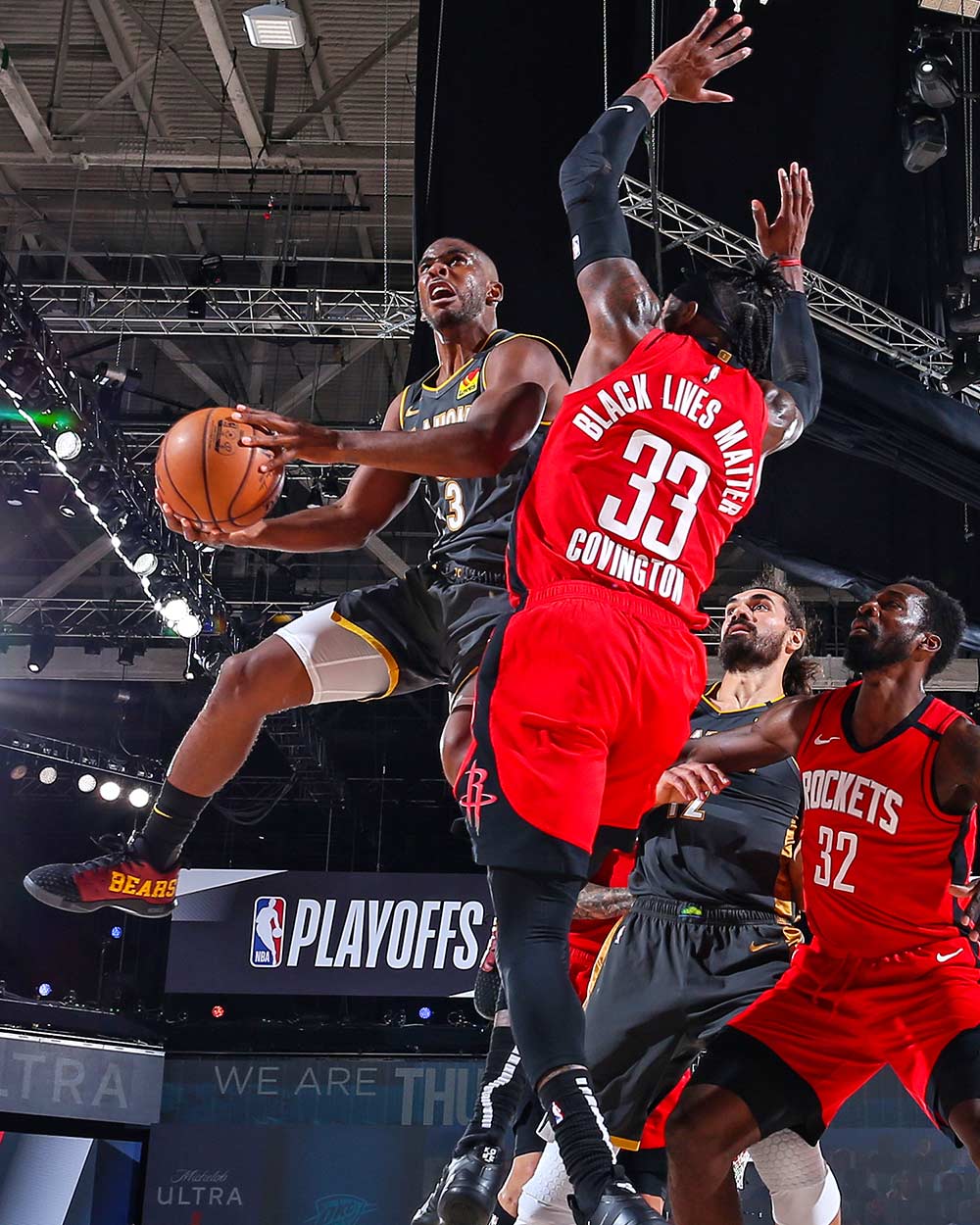
今年10月的第二个星期天,美国职业篮球联赛(NBA)终于决出了总冠军。此时距开赛已经过了12个月,这是个史无前例的时间跨度。
最终,洛杉矶湖人队(Los Angeles Lakers)捧得第74赛季冠军。这是个值得定格的时刻:勒布朗·詹姆斯获得了第四个总冠军,更具历史意义的是,本次胜利已经是他带领第三支球队荣获总冠军。
在带领湖人队战胜迈阿密热火队(Miami Heat)后,詹姆斯完成了带领传奇球队重获昔日辉煌的使命,而在这之前他也曾经两次带热火队得过冠军。
这些成绩奠定了他作为篮球史上最伟大球员之一的地位。
当晚不仅仅是詹姆斯和队友们的胜利,同时也是这格外不平稳的一年里,难得让人振奋的时刻。
过去的这一年对NBA来说,确实很不友好:去年秋天开始,NBA跟中国出现经济纠纷;今年元旦时前总裁大卫·斯特恩意外身亡;几周后已经退役的湖人队巨星科比·布莱恩特遭遇直升机失事不幸去世;随后3月11日,犹他爵士队(Utah Jazz)的一名球员被检测出新冠病毒呈阳性,NBA宣布赛季暂停。这也是新冠肺炎疫情初期的转折点,标志着美国公共卫生危机由此升级。
如今詹姆斯举起拉里·奥布莱恩冠军奖杯,也是NBA停摆结束后得以迅速恢复的证明。
目前为止,故事走向已经众人皆知。
在春季和初夏的大部分时间里,NBA都处于休止状态。但他们在奥兰多迪士尼乐园建立了一个没有观众的封闭赛场,与球员们达成协议后,让联盟30支球队中的22支复赛。(赛场排除了季后赛里并未实际参赛的球队,以减少人数。)
随后两个多月里NBA进行了172场比赛。并且,期间球员、联赛官员或球队工作人员无一人检测出新冠病毒感染。
NBA为这个支离破碎的赛季付出了巨大的代价。仅封闭赛场的支出就高达1.8亿美元。受疫情影响,联盟预测季前收入减少15亿美元。
然而,NBA在逆境中大获成功还是让其他企业艳羡不已。封闭赛场不仅挽救了财务上灾难般的一年,也让全球关注到联赛推出的新产品。此举进一步提升了NBA总裁——职业体育界公认大佬亚当·萧华的声誉。

NBA叫停之后的重启赛季可以说是一项史诗般的壮举——既没有惹来很多异议,也没有滋生额外事端,堪称劳资关系方面教科书式案例。如果考虑到其中涉及的庞大金额和芸芸明星,更算得上是一项非同寻常的成就。由于当前为代际社会关系剧变时期,从超级球星到普通球员都受到深刻影响,连赛季都不止一次受到威胁,如此看来此举的意义更加重大。
为此大笔投入的老板都对这个时间缩短但顺利完成的赛季深感欣慰。
“我认为联赛在尽最大努力保持球队和球员的收入方面做得很出色。”洛杉矶快船队(Los Angeles Clippers)的老板史蒂夫·鲍尔默说,他曾经担任微软公司的首席执行官,也是NBA理事会成员。疫情期间理事会每周都会召开会议。“兼顾各方利益,愿意付出巨大代价从而确保巨大的收益,我认为联赛做得非常好。”
NBA并不是唯一一个疫情期间获得成功的体育联盟:美国女子职业篮球联赛(WNBA)在佛罗里达州西海岸的布拉登顿也采用了类似的封闭赛场;整个赛季期间,国家冰球联盟(NHL)的球队在加拿大的两座城市——多伦多和埃德蒙顿之间往返;美国职业棒球大联盟(Major League Baseball)虽然赛程缩短,也多次受到疫情阻碍,但还是成功进入了季后赛,不过转播比赛时是用纸板为球迷制作人像,放在体育场的座椅上。

而NBA处理封闭赛场的方式再次证明了为何它是全世界管理最佳的体育联盟之一。
“我认为在美国,没有哪个品牌可以同NBA一般始终如一。”美国南加州大学马歇尔商学院的体育商务教授、战略营销顾问、联盟长期观察者大卫·卡特说。“对我来说,品牌是一种承诺,你知道能够从NBA得到什么,就像知道去蒂芙尼和哈雷-戴维森可以买到什么一样。”
卡特说,与其他职业联赛相比,NBA“似乎更为统一,处理重大问题的方式更加一致,无论是新冠疫情,还是社会公正,亦或是有效地打造封闭赛场。”如果研究总结其中原因可以向企业和领导者提供远超体育领域的宝贵经验。
克里斯·保罗是俄克拉荷马城雷霆队(Oklahoma City Thunder)的明星后卫,也是美国篮球运动员协会的主席。他最了解封闭赛场运作的背后具体是哪些因素,由哪些人推动。事实上,他说自己到奥兰多时还专门找了NBA的赛事执行副总裁凯利·弗拉托。
“我只想给她大大的拥抱。”保罗说,“因为之前我们一直在Zoom上开会,谈这谈那,谈了很多后勤问题。”
而本次后勤工作之繁重,在NBA工作14年的老员工弗拉托还是头一次经历。从全明星周末到美国以外,她的团队每年要举办200多场比赛。不过,相关赛事往往提前几年就开始策划,也从来不会超过两支球队。
“这次有22支球队和大约350名球员来到同一个地方。”她说。“我们从来没有应付过如此大的场面。”
今年春末夏初,弗拉托的团队都在Zoom上打电话发信息联系。在他们到达迪士尼世界ESPN环球体育中心后,组成了15人的核心小组,每天早上8点开会讨论当天的任务。有时讨论建造7个练习场,其中一处就在迪士尼世界的酒店宴会厅里,有时讨论如何为没有球迷到场观赛的比赛搭建转播中心。每个星期天,弗拉托都会为近150名跨部门员工举办全员大会,沟通通信、医疗、IT和安全等问题。
在比赛如火如荼时,为奥兰多封闭赛场服务的人则更多,达到6500人。
“感觉有点类似于,当你去看电影时,演员们在银幕上表演,影片结束后工作人员名单一直在滚动,一直滚动……比演员多得多。”总决赛开始前的记者招待会上,NBA总裁亚当·萧华说。(萧华努力说服人们使用“赛场”这个词,而不是“封闭赛场”,但所有人还是称之为封闭赛场。)
他还特别称赞了弗拉托,称她“实际上是全体参赛人员的服务生”。
“从确保大巴准时运行到满足在座各位里要羽毛枕头的人,她都做到了。她知道每个人都是谁,也知晓所有人的需求。”

更值得注意的是,NBA还不得不从头拟定健康协议。
曾经担任过公司内部律师的NBA负责球员事务的高级副总裁大卫·韦斯,迅速学习了传染病和检测方面的知识,与医生团队合作设计了适合封闭赛场管理的健康规则,还定期向球队老板介绍情况。
“联赛的一些工作人员在健康问题方面的反应速度之快,实在令人惊讶。”鲍尔默说。
联赛为所有留在赛场的人制定了每日检测制度,每次检测费用超过100美元。只要有其他人在场,不参加比赛、不执教或不主持比赛的人就必须佩戴口罩,这主要是因为那些支持人员在轮班结束后会离开封闭赛场。
但是,虽然联赛官员能够控制病毒的传播,但他们还得面临其他没有预见到的挑战。
8月26日,季后赛进行过半,密尔沃基雄鹿队(Milwaukee Bucks)为了对威斯康星州基诺沙一名警官射杀了一位名叫雅各布·布莱克的黑人男子表示抗议,在更衣室里拒绝参加季后赛第五场与奥兰多魔术队(Orlando Magic)的比赛。
刚开始只是一场罢赛,也有人称其为抵制,而萧华则更愿意称之为“停工”,很快NBA和其他体育联盟全面停赛。
第二天,奥兰多剩下的球员和教练聚集商议是否愿意重返球场。该赛季以及季后赛打完后各参与方可以获得的收入仍然悬而未决。
聚会前,球员工会主席保罗曾经与萧华交谈。交流非常直接,这也说明双方互相信任。
“我只是说:‘到时会告诉你。’”保罗说,“我知道这听起来很简单。但情况确实如此,你知道吗?说到底显然我们还是合作伙伴,一切都是为了比赛。但我是球员。我知道球员的感受。球员的感受比篮球比赛重要。”
聚会本身也成了运动员们集体宣泄情绪的好机会。
“罢赛并不是好事,但看到150人在拥挤的宴会厅里尖叫、叫喊、大笑、哭泣,最后像兄弟一样团结,还是很令人吃惊。”美国篮球运动员协会的执行董事米歇尔·罗伯茨说。“我从未见过这样的场面。这就是民主。真的太棒了。”

第二天,经过进一步讨论,球员同意恢复比赛,因为他们与球队老板达成了协议:全国各地的体育场都要被用作即将到来的大选的投票站。
世界各地的企业,特别是那些有公会成员员工的企业,在疫情导致企业亏损时期也不得不处理敏感的劳资问题。
但与大多数体育联盟相比,NBA相对顺利,因为联盟一直在与球员之间相互适应。
“萧华和罗伯茨的威望很高。”劳工律师乔舒亚·门德尔松说,他也是《薪资上限》一书的作者,书中内容讲述了NBA劳资关系历史,主要介绍1983年引入工资上限。
赛季暂停,收入停发时,老板原本可以停止支付。但他们没有这么做。
“老板继续付给球员工资。”门德尔松说。“工会谈判做得很好,包括如果出现伤病的责任上限。他们听取了球员的意见。没有球员,就没有比赛。”
早在封闭球场之前,这种相互理解就发挥过作用。
在5月底,明尼阿波利斯的警察致黑人乔治·弗洛伊德死亡后,引发的社会示威活动激增,许多球星不确定是否应该复赛。他们担心会分散全国关于种族问题的讨论。
其实,球员们也深之复赛对他们来说,意味着机会。
“我们理解不复赛的经济后果和财务影响。”迈阿密热火队的前锋,球员工会的第一副主席安德烈·伊戈达拉表示。但是和种族关系这种社会问题的变化比金钱更重要。所以很多人会说:‘让我们为更宏大的目标努力,而不仅仅是为了钱。’”
因此,他们商定,在球衣背面印上“投票”和“说出他们的名字”等与黑人人权运动有关的信息。这是萧华和罗伯茨在谈判中颇具经验的一种妥协。
罗伯茨说:“我和亚当吵过架。并不是一直都很顺利,到最后,我们确实处理得比较成熟。”
不管NBA在今年的糟糕形势下多么成功,但也无法逆转疫情重创联盟财务的事实,就像世界各地的许多企业一样。
在去年秋天赛季开始时,联盟曾经预计本赛季收入可达100亿美元,其中约40%来自所谓的“比赛夜收入”,包括门票、特许经营权、周边商品等。
虽然停赛前赛季已经完成了约80%,但当球迷们无法观赛时,收入自然就中断了。

另一方面,在NBA本土市场,电视转播也受到了挑战。
体育媒体Sports Media Watch的分析师乔恩·“保尔森”·刘易斯称,迪士尼旗下的ABC电视台播出了最佳7场冠军争夺赛的第一场,收视率仅为4.1,观看人数741万,为NBA总决赛单场比赛最低纪录。
刘易斯估计,今年的比赛收视率比去年下降了至少40%。
在职业体育联盟中,并不只有NBA收视率下降。刘易斯估计,国家冰球联盟的斯坦利杯决赛的收视率下降了61%。赛制改革后,美国职棒大联盟的常规赛观众比之前一年少了四分之一。
时机不佳是NBA收视率下滑的原因之一。
总决赛完赛通常在6月,而不是10月,因为10月要跟橄榄球和棒球等项目竞争。在9月里,最夸张的一天居然有12项顶级体育项目比赛,包括橄榄球联盟、女子篮球联盟、美国网球公开赛和大学橄榄球赛等。
此外,NBA还赶上了全民瞩目的选举季。举个例子,总决赛第三场比赛那天,媒体都在铺天盖地报道总统特朗普的新冠检测呈阳性结果。
封闭赛场的结束,意味着新的艰难篇章的开启。
球员、球队老板和联盟官员都有大堆工作要做。劳资协议集体谈判已经在进行中。推迟的NBA选秀定于11月18日举行。联盟已经提出了想要于明年1月开始下个赛季的想法,但球迷能否到现场观赛还不确定。
未来几周争论的焦点可能是如何最好、最公平地分担联赛面临的财务压力。
罗伯茨说:“毫无疑问,谈判主要围绕着如何在长期内摊平亏损而展开。”
对于NBA里1500人左右的文职人员来说,至少在决赛后迎来了好消息。
萧华通过电子邮件宣布,每人可以一次性获得1000美元奖金,还有连续四个星期五和整个感恩节的假期。
至于萧华本人,最后一场比赛后,在其他工作人员纷纷离开封闭赛场之际,他并没有飞回北边。
几天后他告诉《财富》杂志:“信不信由你,我还在奥兰多,我妻子和两个女儿来了南方,我们要去迪士尼乐园玩两天。就像广告里说的:‘冠军赛后打算干什么?去迪士尼乐园玩。’”
这并不是童话标准结局。毕竟,疫情仍然在肆虐。
但在这样兵荒马乱的一年,还能去迪士尼乐园逛一圈,这已经相当完美了。(财富中文网)
补充报道:柳仕鲁(Andrew Nusca)。
本文另一版本登载于《财富》杂志2020年11月刊。
译者:冯丰
审校:夏林
编辑:徐晓彤
今年10月的第二个星期天,美国职业篮球联赛(NBA)终于决出了总冠军。此时距开赛已经过了12个月,这是个史无前例的时间跨度。
最终,洛杉矶湖人队(Los Angeles Lakers)捧得第74赛季冠军。这是个值得定格的时刻:勒布朗·詹姆斯获得了第四个总冠军,更具历史意义的是,本次胜利已经是他带领第三支球队荣获总冠军。
在带领湖人队战胜迈阿密热火队(Miami Heat)后,詹姆斯完成了带领传奇球队重获昔日辉煌的使命,而在这之前他也曾经两次带热火队得过冠军。
这些成绩奠定了他作为篮球史上最伟大球员之一的地位。
当晚不仅仅是詹姆斯和队友们的胜利,同时也是这格外不平稳的一年里,难得让人振奋的时刻。
过去的这一年对NBA来说,确实很不友好:去年秋天开始,NBA跟中国出现经济纠纷;今年元旦时前总裁大卫·斯特恩意外身亡;几周后已经退役的湖人队巨星科比·布莱恩特遭遇直升机失事不幸去世;随后3月11日,犹他爵士队(Utah Jazz)的一名球员被检测出新冠病毒呈阳性,NBA宣布赛季暂停。这也是新冠肺炎疫情初期的转折点,标志着美国公共卫生危机由此升级。
如今詹姆斯举起拉里·奥布莱恩冠军奖杯,也是NBA停摆结束后得以迅速恢复的证明。
目前为止,故事走向已经众人皆知。
在春季和初夏的大部分时间里,NBA都处于休止状态。但他们在奥兰多迪士尼乐园建立了一个没有观众的封闭赛场,与球员们达成协议后,让联盟30支球队中的22支复赛。(赛场排除了季后赛里并未实际参赛的球队,以减少人数。)
随后两个多月里NBA进行了172场比赛。并且,期间球员、联赛官员或球队工作人员无一人检测出新冠病毒感染。
NBA为这个支离破碎的赛季付出了巨大的代价。仅封闭赛场的支出就高达1.8亿美元。受疫情影响,联盟预测季前收入减少15亿美元。
然而,NBA在逆境中大获成功还是让其他企业艳羡不已。封闭赛场不仅挽救了财务上灾难般的一年,也让全球关注到联赛推出的新产品。此举进一步提升了NBA总裁——职业体育界公认大佬亚当·萧华的声誉。
NBA叫停之后的重启赛季可以说是一项史诗般的壮举——既没有惹来很多异议,也没有滋生额外事端,堪称劳资关系方面教科书式案例。如果考虑到其中涉及的庞大金额和芸芸明星,更算得上是一项非同寻常的成就。由于当前为代际社会关系剧变时期,从超级球星到普通球员都受到深刻影响,连赛季都不止一次受到威胁,如此看来此举的意义更加重大。
为此大笔投入的老板都对这个时间缩短但顺利完成的赛季深感欣慰。
“我认为联赛在尽最大努力保持球队和球员的收入方面做得很出色。”洛杉矶快船队(Los Angeles Clippers)的老板史蒂夫·鲍尔默说,他曾经担任微软公司的首席执行官,也是NBA理事会成员。疫情期间理事会每周都会召开会议。“兼顾各方利益,愿意付出巨大代价从而确保巨大的收益,我认为联赛做得非常好。”
NBA并不是唯一一个疫情期间获得成功的体育联盟:美国女子职业篮球联赛(WNBA)在佛罗里达州西海岸的布拉登顿也采用了类似的封闭赛场;整个赛季期间,国家冰球联盟(NHL)的球队在加拿大的两座城市——多伦多和埃德蒙顿之间往返;美国职业棒球大联盟(Major League Baseball)虽然赛程缩短,也多次受到疫情阻碍,但还是成功进入了季后赛,不过转播比赛时是用纸板为球迷制作人像,放在体育场的座椅上。
而NBA处理封闭赛场的方式再次证明了为何它是全世界管理最佳的体育联盟之一。
“我认为在美国,没有哪个品牌可以同NBA一般始终如一。”美国南加州大学马歇尔商学院的体育商务教授、战略营销顾问、联盟长期观察者大卫·卡特说。“对我来说,品牌是一种承诺,你知道能够从NBA得到什么,就像知道去蒂芙尼和哈雷-戴维森可以买到什么一样。”
卡特说,与其他职业联赛相比,NBA“似乎更为统一,处理重大问题的方式更加一致,无论是新冠疫情,还是社会公正,亦或是有效地打造封闭赛场。”如果研究总结其中原因可以向企业和领导者提供远超体育领域的宝贵经验。
克里斯·保罗是俄克拉荷马城雷霆队(Oklahoma City Thunder)的明星后卫,也是美国篮球运动员协会的主席。他最了解封闭赛场运作的背后具体是哪些因素,由哪些人推动。事实上,他说自己到奥兰多时还专门找了NBA的赛事执行副总裁凯利·弗拉托。
“我只想给她大大的拥抱。”保罗说,“因为之前我们一直在Zoom上开会,谈这谈那,谈了很多后勤问题。”
而本次后勤工作之繁重,在NBA工作14年的老员工弗拉托还是头一次经历。从全明星周末到美国以外,她的团队每年要举办200多场比赛。不过,相关赛事往往提前几年就开始策划,也从来不会超过两支球队。
“这次有22支球队和大约350名球员来到同一个地方。”她说。“我们从来没有应付过如此大的场面。”
今年春末夏初,弗拉托的团队都在Zoom上打电话发信息联系。在他们到达迪士尼世界ESPN环球体育中心后,组成了15人的核心小组,每天早上8点开会讨论当天的任务。有时讨论建造7个练习场,其中一处就在迪士尼世界的酒店宴会厅里,有时讨论如何为没有球迷到场观赛的比赛搭建转播中心。每个星期天,弗拉托都会为近150名跨部门员工举办全员大会,沟通通信、医疗、IT和安全等问题。
在比赛如火如荼时,为奥兰多封闭赛场服务的人则更多,达到6500人。
“感觉有点类似于,当你去看电影时,演员们在银幕上表演,影片结束后工作人员名单一直在滚动,一直滚动……比演员多得多。”总决赛开始前的记者招待会上,NBA总裁亚当·萧华说。(萧华努力说服人们使用“赛场”这个词,而不是“封闭赛场”,但所有人还是称之为封闭赛场。)
他还特别称赞了弗拉托,称她“实际上是全体参赛人员的服务生”。
“从确保大巴准时运行到满足在座各位里要羽毛枕头的人,她都做到了。她知道每个人都是谁,也知晓所有人的需求。”
更值得注意的是,NBA还不得不从头拟定健康协议。
曾经担任过公司内部律师的NBA负责球员事务的高级副总裁大卫·韦斯,迅速学习了传染病和检测方面的知识,与医生团队合作设计了适合封闭赛场管理的健康规则,还定期向球队老板介绍情况。
“联赛的一些工作人员在健康问题方面的反应速度之快,实在令人惊讶。”鲍尔默说。
联赛为所有留在赛场的人制定了每日检测制度,每次检测费用超过100美元。只要有其他人在场,不参加比赛、不执教或不主持比赛的人就必须佩戴口罩,这主要是因为那些支持人员在轮班结束后会离开封闭赛场。
但是,虽然联赛官员能够控制病毒的传播,但他们还得面临其他没有预见到的挑战。
8月26日,季后赛进行过半,密尔沃基雄鹿队(Milwaukee Bucks)为了对威斯康星州基诺沙一名警官射杀了一位名叫雅各布·布莱克的黑人男子表示抗议,在更衣室里拒绝参加季后赛第五场与奥兰多魔术队(Orlando Magic)的比赛。
刚开始只是一场罢赛,也有人称其为抵制,而萧华则更愿意称之为“停工”,很快NBA和其他体育联盟全面停赛。
第二天,奥兰多剩下的球员和教练聚集商议是否愿意重返球场。该赛季以及季后赛打完后各参与方可以获得的收入仍然悬而未决。
聚会前,球员工会主席保罗曾经与萧华交谈。交流非常直接,这也说明双方互相信任。
“我只是说:‘到时会告诉你。’”保罗说,“我知道这听起来很简单。但情况确实如此,你知道吗?说到底显然我们还是合作伙伴,一切都是为了比赛。但我是球员。我知道球员的感受。球员的感受比篮球比赛重要。”
聚会本身也成了运动员们集体宣泄情绪的好机会。
“罢赛并不是好事,但看到150人在拥挤的宴会厅里尖叫、叫喊、大笑、哭泣,最后像兄弟一样团结,还是很令人吃惊。”美国篮球运动员协会的执行董事米歇尔·罗伯茨说。“我从未见过这样的场面。这就是民主。真的太棒了。”
第二天,经过进一步讨论,球员同意恢复比赛,因为他们与球队老板达成了协议:全国各地的体育场都要被用作即将到来的大选的投票站。
世界各地的企业,特别是那些有公会成员员工的企业,在疫情导致企业亏损时期也不得不处理敏感的劳资问题。
但与大多数体育联盟相比,NBA相对顺利,因为联盟一直在与球员之间相互适应。
“萧华和罗伯茨的威望很高。”劳工律师乔舒亚·门德尔松说,他也是《薪资上限》一书的作者,书中内容讲述了NBA劳资关系历史,主要介绍1983年引入工资上限。
赛季暂停,收入停发时,老板原本可以停止支付。但他们没有这么做。
“老板继续付给球员工资。”门德尔松说。“工会谈判做得很好,包括如果出现伤病的责任上限。他们听取了球员的意见。没有球员,就没有比赛。”
早在封闭球场之前,这种相互理解就发挥过作用。
在5月底,明尼阿波利斯的警察致黑人乔治·弗洛伊德死亡后,引发的社会示威活动激增,许多球星不确定是否应该复赛。他们担心会分散全国关于种族问题的讨论。
其实,球员们也深之复赛对他们来说,意味着机会。
“我们理解不复赛的经济后果和财务影响。”迈阿密热火队的前锋,球员工会的第一副主席安德烈·伊戈达拉表示。但是和种族关系这种社会问题的变化比金钱更重要。所以很多人会说:‘让我们为更宏大的目标努力,而不仅仅是为了钱。’”
因此,他们商定,在球衣背面印上“投票”和“说出他们的名字”等与黑人人权运动有关的信息。这是萧华和罗伯茨在谈判中颇具经验的一种妥协。
罗伯茨说:“我和亚当吵过架。并不是一直都很顺利,到最后,我们确实处理得比较成熟。”
不管NBA在今年的糟糕形势下多么成功,但也无法逆转疫情重创联盟财务的事实,就像世界各地的许多企业一样。
在去年秋天赛季开始时,联盟曾经预计本赛季收入可达100亿美元,其中约40%来自所谓的“比赛夜收入”,包括门票、特许经营权、周边商品等。
虽然停赛前赛季已经完成了约80%,但当球迷们无法观赛时,收入自然就中断了。
另一方面,在NBA本土市场,电视转播也受到了挑战。
体育媒体Sports Media Watch的分析师乔恩·“保尔森”·刘易斯称,迪士尼旗下的ABC电视台播出了最佳7场冠军争夺赛的第一场,收视率仅为4.1,观看人数741万,为NBA总决赛单场比赛最低纪录。
刘易斯估计,今年的比赛收视率比去年下降了至少40%。
在职业体育联盟中,并不只有NBA收视率下降。刘易斯估计,国家冰球联盟的斯坦利杯决赛的收视率下降了61%。赛制改革后,美国职棒大联盟的常规赛观众比之前一年少了四分之一。
时机不佳是NBA收视率下滑的原因之一。
总决赛完赛通常在6月,而不是10月,因为10月要跟橄榄球和棒球等项目竞争。在9月里,最夸张的一天居然有12项顶级体育项目比赛,包括橄榄球联盟、女子篮球联盟、美国网球公开赛和大学橄榄球赛等。
此外,NBA还赶上了全民瞩目的选举季。举个例子,总决赛第三场比赛那天,媒体都在铺天盖地报道总统特朗普的新冠检测呈阳性结果。
封闭赛场的结束,意味着新的艰难篇章的开启。
球员、球队老板和联盟官员都有大堆工作要做。劳资协议集体谈判已经在进行中。推迟的NBA选秀定于11月18日举行。联盟已经提出了想要于明年1月开始下个赛季的想法,但球迷能否到现场观赛还不确定。
未来几周争论的焦点可能是如何最好、最公平地分担联赛面临的财务压力。
罗伯茨说:“毫无疑问,谈判主要围绕着如何在长期内摊平亏损而展开。”
对于NBA里1500人左右的文职人员来说,至少在决赛后迎来了好消息。
萧华通过电子邮件宣布,每人可以一次性获得1000美元奖金,还有连续四个星期五和整个感恩节的假期。
至于萧华本人,最后一场比赛后,在其他工作人员纷纷离开封闭赛场之际,他并没有飞回北边。
几天后他告诉《财富》杂志:“信不信由你,我还在奥兰多,我妻子和两个女儿来了南方,我们要去迪士尼乐园玩两天。就像广告里说的:‘冠军赛后打算干什么?去迪士尼乐园玩。’”
这并不是童话标准结局。毕竟,疫情仍然在肆虐。
但在这样兵荒马乱的一年,还能去迪士尼乐园逛一圈,这已经相当完美了。(财富中文网)
补充报道:柳仕鲁(Andrew Nusca)。
本文另一版本登载于《财富》杂志2020年11月刊。
译者:冯丰
审校:夏林
编辑:徐晓彤
On the second Sunday in October, an unprecedented 12 months after the National Basketball Association’s 74th season tipped off with preseason games, the league finally crowned a champion—the Los Angeles Lakers. It was a made-for-TV moment: LeBron James captured his fourth title and, more historically, did it with his third team. By leading the Lakers to victory against the feisty Miami Heat—the team with which he won his first two rings—James completed his mission to restore the storied franchise to its past glory. He also solidified his claim as one of the game’s all-time greatest players.
But the night was about so much more than the triumph by James and his teammates. It also was the capstone to a year of unprecedented tumult that included a financially painful spat with China last fall, the unexpected death of former commissioner David Stern on New Year’s Day, and the tragic demise weeks later of retired Laker superstar Kobe Bryant in a helicopter crash. And that was all before the NBA suspended its season on March 11 after a Utah Jazz player tested positive for COVID-19—a watershed moment in the early days of the pandemic that reinforced the seriousness of the health crisis at hand.
That James was able to hoist the Larry O’Brien trophy at all is a testament to how the NBA rebounded in the weeks and months after the shutdown. By now the outline of the story is well known. Shuttered for much of the spring and early summer, the NBA crafted a plan for a Disney-hosted bubble in Orlando and worked out an arrangement with the players to restart play with 22 of the league’s 30 teams. (The bubble excluded teams without a realistic shot at the playoffs to reduce headcount.) It then proceeded to stage 172 games over two-plus months without a single player, league official, or team staffer testing positive for the novel coronavirus.
The NBA’s fractured season came at a tremendous cost. Bubble expenses alone totaled about $180 million, and the league undershot its preseason revenue projections by as much as $1.5 billion because of the pandemic. Yet the overall success of the NBA in the face of adversity is something many other businesses can only dream of. The bubble not only salvaged what could have been a devastating year financially, but it also put a global spotlight on the league’s product. And it further boosted the reputation of NBA commissioner Adam Silver, considered by many to be the best in professional sports.
Restarting a season after stopping it cold was an operational feat of epic proportions. And pulling it off with a minimum of dissent and drama represents a textbook case of labor relations done right—a nontrivial achievement given the amount of money and the size of the egos involved. The feat is all the more remarkable given that it came about during a period of generational social justice upheaval that profoundly affected the NBA’s players, from superstars to scrubs, and that at more than one point threatened to torpedo the season.
Those with the most on the line seem to appreciate the victory of a shortened but healthy season. “I think the league did a masterful job of doing the best it could to keep revenue coming in for both the teams and the players,” says Los Angeles Clippers owner Steve Ballmer, the former Microsoft CEO and a member of the NBA’s board of governors, which met weekly throughout the crisis. “Juggling those interests and being willing to put in some significant costs with some significant benefit, I just think the league was phenomenal.”
The NBA wasn’t the only sports league to snatch victory from the jaws of a pandemic. The WNBA pulled off a similar bubble experience in Bradenton, Fla., on the state’s west coast. NHL teams finished the season shuttling between two Canadian cities, Toronto and Edmonton. And even Major League Baseball, though hampered by multiple outbreaks of the virus over the course of a truncated schedule, has managed to make it deep into its playoffs with televised games in stadiums with cardboard cutouts for fans.
But by mastering the bubble the way it did, the NBA showed once again why it is viewed as one of the world’s best-managed sports leagues. “I don’t think there’s a brand in America that is more consistent than the NBA,” says David Carter, a sports business professor at USC’s Marshall School of Business, strategic marketing consultant, and longtime observer of the league. “To me, a brand is a promise, and you know what you’re going to get out of the NBA, just as you know what you’re going to get out of Tiffany and Harley-Davidson.”
Compared with other professional leagues, says Carter, the NBA “just seemed to be more uniform, more in lockstep for how they handled major issues, whether it’s COVID, or social justice, or putting together a bubble that works.” And understanding why reveals valuable lessons for businesses and leaders well beyond the realm of sports.
*****
Chris Paul, the star guard for the Oklahoma City Thunder and the president of the National Basketball Players Association, knows firsthand what, and who, it took to make the bubble work. In fact, when he arrived in Orlando he says he sought out Kelly Flatow, executive vice president for events for the NBA. “I just wanted to give her the biggest hug,” says Paul. “Because we had been on all these Zooms together where we’d been talking about this, talking about that, talking about logistics.”
The logistics were like nothing Flatow, a 14-year veteran of the NBA, had ever seen. Her group puts on more than 200 events a year, from the All-Star weekend to games outside the U.S. Planning for these events begins years in advance, though, and they never involve more than two teams. “This was having 22 teams and roughly 350 players, all coming together in one environment,” she says. “There was no playbook or blueprint for this.”
Flatow’s team spent the late spring and early summer on Zoom calls and messaging each other on Slack from their respective homes near New York City. After they got to the Disney World ESPN World Wide Sports Complex, home base to the bubble, a core group of 15 met daily at 8 a.m. to discuss the tasks of the day—whether it was building seven practice facilities, including one that went up in a Disney World hotel ballroom, or erecting a broadcast center for games without fans. Every Sunday Flatow hosted an all-hands meeting for the cross-functional staff of nearly 150 that spanned communications and medical to IT and security.
By the time games were in full swing, it took an even larger number, a proverbial 6,500-person village, to service the entire community in the bubble in Orlando. “I analogize it a bit to when you go to a movie and you see the actors on the screen and then the credits start rolling at the end, and they keep rolling and they keep rolling,” Adam Silver, the NBA commissioner, said at a press conference before the finals series began. (Silver gamely tried to persuade people to use the word “campus” rather than “bubble.” Everyone called it a bubble.) He singled out Flatow for praise, calling her “in essence the concierge” for the assembled crew.
She did “everything from making sure the buses run on time to [assisting] those of you in this room who requested feather pillows. I know who you are. I know all the personal requests that everyone here has made.”
More seriously, the NBA also had to invent health protocols from scratch. A former corporate lawyer named David Weiss, the NBA’s senior vice president for player matters, quickly learned enough about infectious diseases and testing to work with a team of doctors to design the elaborate health rules that governed the bubble. Weiss also regularly briefed the owners. “It was absolutely stunning how fast some of the league staff came up to speed on the health issues,” says Ballmer.
The league established a daily testing regimen for everyone who stayed on the campus at an expense of more than $100 per test. Everyone not playing, coaching, or officiating games were required to wear masks in the presence of others, particularly because support staff left the bubble after their shifts.
But while league officials were able to stay ahead of the virus, there were other challenges they didn’t see coming.
*****
On Aug. 26, in the middle of the playoffs, the Milwaukee Bucks chose not to come out of their locker room for their Game 5 playoff matchup with the Orlando Magic. They made the decision not to play in order to protest the shooting of a Black man named Jacob Blake by a police officer in Kenosha, Wis. What began as a one-game walkout—some called it a boycott, while Silver let it be known he preferred “work stoppage”—quickly cascaded into a full cessation of play in the NBA as well as other sports leagues. The next day the remaining players and coaches in Orlando gathered to decide if they would return to the court. The season—and the revenue all parties would reap from completing the playoffs—hung in the balance.
Before the meeting, Paul, the players’ union president, spoke with Silver. The directness of the exchange is illustrative of the trust that the two sides have in each other. “I just said, ‘I’ll let you know,’ ” says Paul. “I know it sounds simple. But that’s real, you know? At the end of the day, obviously we’re partners and it’s all about the game. But I’m a player. I know how players feel. And this was bigger than the game.”
The meeting itself was an extraordinary moment of mass catharsis for the athletes. “It was not fun, but it was really astonishing to see 150 men spend hours in this crowded banquet hall screaming, yelling, laughing, crying, but ultimately coming together as brothers,” says Michele Roberts, executive director of the National Basketball Players Association. “I’ve never seen anything like it. That’s what democracy looks like. And it was quite stunning.”
After more discussion the next day, the players agreed to go back to work, encouraged by an agreement with team owners that stadiums across the country would be used as polling stations for the upcoming election.
Businesses everywhere, especially those with unionized workforces, have had to deal with sensitive labor-relations issues during this time of pandemic-induced business shortfalls. But more than most leagues, the NBA came into its difficult year enjoying a history of mutual accommodation with its players. “Silver and Roberts have a ton of credibility,” says Joshua Mendelsohn, a labor lawyer and author of The Cap, a new history of labor relations at the NBA centered on the introduction of a salary cap in 1983. When the season was suspended and revenue stopped flowing, the owners could have ceased paying salaries. They didn’t. “The owners continued to pay the players,” says Mendelsohn. “The union did a good job of negotiating, including upping the liability if someone got sick. They listened to the players. Without the players, there is no game.”
That mutual understanding paid dividends before play even began in the bubble. After the killing of George Floyd by police officers in Minneapolis in late May, and the surge in social justice demonstrations that it sparked, many of the league’s stars were unsure they should resume the season. They feared distracting from the national conversation about race.
But the players also recognized the platform they would have by returning. “We understood the economic ramifications and the financials of not returning,” says Andre Iguodala, the Miami Heat forward and first vice president of the players’ union. “But the political landscape of the country and what was happening with race relations made it bigger than money. And I think that’s what made it special for a lot of us to say, ‘Let’s do it for a bigger reason than just us going out and getting a check.’ ”
So they negotiated to have certain approved messages—like “Vote” and “Say Their Names”—associated with the Black Lives Matter movement printed on the backs of their jerseys. It’s the kind of compromise that Silver and Roberts are experienced at negotiating. “I have had fights with Adam. It’s not hunky-dory all the time,” says Roberts. “But at the end of the day, we do behave like adults.”
*****
No matter how successful the NBA was in making the best of a bad situation this year, the fact remains that the pandemic slammed the league’s finances in the same manner it has hurt so many businesses around the world. The league entered last fall expecting to collect $10 billion for the season, with about 40% of that figure coming from so-called game-night revenue: tickets, concessions, merchandise, and the like. Though the league did complete about 80% of its season before it was suspended, this revenue stream went away the moment fans stopped being able to attend games.
Television was challenged in the NBA’s home market, too, for very different reasons. The first game of the best-of-seven championship series broadcast on Disney-owned ABC, garnered the smallest television audience ever recorded for a single game in the NBA Finals—a 4.1 rating with 7.41 million viewers, according to analyst Jon “Paulsen” Lewis of Sports Media Watch. Lewis estimates that viewership for this year’s series was down by at least 40% from last year.
The NBA is hardly alone among professional sports leagues in seeing viewership declines. Viewership for the NHL’s Stanley Cup Final was down 61%, Lewis estimates. And the reworked MLB regular season lost a quarter of its audience from the year before.
Unfortunate timing is partly to blame for the NBA’s ratings slide. The finals usually conclude in June rather than October, when it is competing with football and baseball, among other sports. One extraordinary day in September featured events from 12 top sports, including Major League Soccer, the WNBA, tennis’s U.S. Open, and college football. The NBA even had to contend with a crazy election season. Game 3 of the finals competed, for example, with wall-to-wall coverage of President Trump’s surprise COVID-19 diagnosis.
*****
The end of the bubble means the beginning of a new, difficult chapter. There’s plenty of work ahead—for the players, the owners, and league officials. Negotiations to revisit the collective bargaining agreement already are underway. The delayed NBA draft is slated for Nov. 18. And the league has floated the idea of beginning the next season in January, with the presence of fans uncertain. Indeed the biggest debate in the weeks ahead will likely be about the best and fairest way to share the financial hit the league is facing. Says Roberts: “It’s no secret the conversation will entail how to spread the loss over a longer period.”
The NBA’s 1,500 or so league-office employees, at least, got some post-finals good news. Silver told them by email that each would receive a one-time $1,000 bonus as well as four consecutive Fridays and all of Thanksgiving week off.
As for the commissioner himself, he didn’t fly north when most of the rest of the league staff fled the bubble following the last game. “Believe it or not, I’m still in Orlando,” he told Fortune a couple of days later. “My wife and our two daughters came down, and we’re going to Disney World for two days. It’s like that commercial: ‘What are you going to do after the championship? We’re going to Disney World.’ ”
It’s not entirely a fairy tale ending. The pandemic is still raging, after all. But it’s about as close as anyone’s going to get to one in a year like this.
Additional reporting by Andrew Nusca.
A version of this article appears in the November 2020 issue of Fortune.






